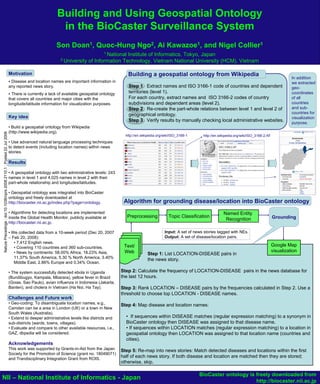
Building and Using Geospatial Ontology in the BioCaster Surveillance System
- 1. Building and Using Geospatial Ontology in the BioCaster Surveillance System Son Doan1, Quoc-Hung Ngo2, Ai Kawazoe1, and Nigel Collier1 1 National Institute of Informatics, Tokyo, Japan 2 University of Information Technology, Vietnam National University (HCM), Vietnam Motivation Building a geospatial ontology from Wikipedia In addition Disease and location names are important information in we extracted any reported news story. Step 1 Extract names and ISO 3166-1 code of countries and dependent geo- There is currently a lack of available geospatial ontology territories (level 1). coordinates that covers all countries and major cities with the For each country, extract names and ISO 3166-2 codes of country of all longitude/latitude information for visualization purposes. subdivisions and dependent areas (level 2). countries Step 2 Re-create the part-whole relations between level 1 and level 2 of and sub- geographical ontology. countries for Key idea visualization Step 3 Verify results by manually checking local administrative websites. purpose. • Build a geospatial ontology from Wikipedia (http://www.wikipedia.org). Nature Precedings : doi:10.1038/npre.2008.2110.1 : Posted 22 Jul 2008 http://en.wikipedia.org/wiki/ISO_3166-1 http://en.wikipedia.org/wiki/ISO_3166-2:AF • Use advanced natural language processing techniques to detect events (including location names) within news stories. Results • A geospatial ontology with two administrative levels: 243 names in level 1 and 4,025 names in level 2 with their part-whole relationship and longitudes/latitudes. • Geospatial ontology was integrated into BioCaster ontology and freely downloaded at http://biocaster.nii.ac.jp/index.php?page=ontology. Algorithm for grounding disease/location into BioCaster ontology • Algorithms for detecting locations are implemented Named Entity inside the Global Health Monitor, publicly available at Preprocessing Topic Classification Grounding Recognition http://biocaster.nii.ac.jp. • We collected data from a 10-week period (Dec 20, 2007 Input: A set of news stories tagged with NEs. – Feb 20, 2008): Output: A set of disease/location pairs. • 7,412 English news. • Covering 110 countries and 360 sub-countries. Text/ Google Map • News by continents: 58.00% Africa, 18.23% Asia, Web visualization Step 1: List LOCATION-DISEASE pairs in 11.37% South America, 5.30 % North America, 3.40% the news story. Middle East, 2.86% Europe and 0.34% Ocean. • The system successfully detected ebola in Uganda Step 2: Calculate the frequency of LOCATION-DISEASE pairs in the news database for (Bundibugyo, Kampala, Mbarara), yellow fever in Brazil the last 12 hours. (Goias, Sao Paulo), avian influenza in Indonesia (Jakarta, Banten), and cholera in Vietnam (Ha Noi, Ha Tay). Step 3: Rank LOCATION – DISEASE pairs by the frequencies calculated in Step 2. Use a threshold to choose top LOCATION - DISEASE names. Challenges and Future work • Geo-coding: To disambiguate location names, e.g., Step 4: Map disease and location names: Camden can be a area in London (UK) or a town in New South Wales (Australia). • Extend to deeper administrative levels like districts and • If sequences within DISEASE matches (regular expression matching) to a synonym in sub-districts (wards, towns, villages). BioCaster ontology then DISEASE was assigned to that disease name. • Evaluate and compare to other available resources, i.e., • If sequences within LOCATION matches (regular expression matching) to a location in GAZ, dbpedia will be considered. geospatial ontology then LOCATION was assigned to that location name (countries and cities). Acknowledgements This work was supported by Grants-in-Aid from the Japan Step 5: Re-map into news stories: Match detected diseases and locations within the first Society for the Promotion of Science (grant no. 18049071) and Trandisciplinary Integration Grant from ROIS. half of each news story. If both disease and location are matched then they are stored; otherwise, skip. BioCaster ontology is freely downloaded from NII – National Institute of Informatics - Japan http://biocaster.nii.ac.jp
